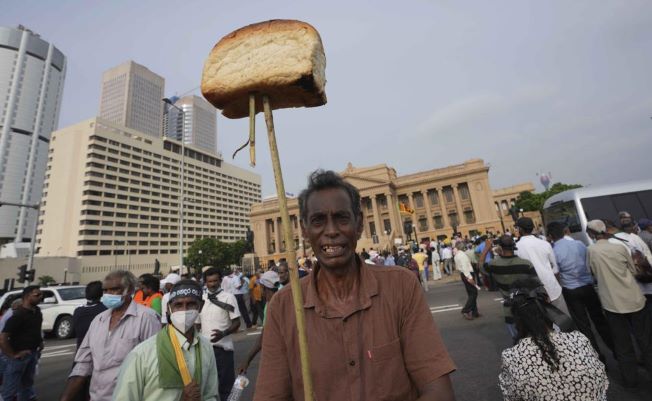Sri Lanka shows the folly of fringe theories

By Mihir Sharma
Cranks are considered cranks for a reason. That is the lesson from Sri Lanka, which has halted payments of its foreign debt and warned that it may default.
The country’s ruling dynasty — led by President Gotabaya Rajapaksa and his brother, Prime Minister (and former president) Mahinda Rajapaksa — have lost most of their cabinet and parliamentary majority. Earlier this month, a newly appointed finance minister tried to resign after less than 24 hours, saying the pressure was too much for him. (He was replacing Basil Rajapaksa, another brother.)
Suffering is widespread. The country cannot pay for imports, so food and fuel are running short, leading to 13-hour blackouts and rationing. Inflation is running at nearly 19% and the central bank has just doubled interest rates.
How did this tiny Indian Ocean nation end up in such straits? Yes, structural factors played a role. China-financed infrastructure follies soaked up scarce capital. Profligate politicians cut taxes unwisely. The pandemic battered the tourism sector and, of course, Russia’s invasion of Ukraine has made everything worse.
But the deeper problem is that the Rajapaksas turned Sri Lanka’s policymaking over to cranks, especially in two crucial fields — agriculture and monetary policy.
Last April, the government followed through on a campaign promise to transition Sri Lanka to organic farming by banning the import and use of synthetic fertilizers. More than two-thirds of Sri Lanka’s people are directly or indirectly dependent on agriculture; economists and agronomists warned that a transition to organic farming on that scale would destroy productivity and cause incomes to crash.
Nevertheless, the irrigation minister, Chamal Rajapaksa (yes, yet another brother) insisted that the country should not listen to the “chemical fertilizer mafia”. Pro-organic activists also received crucial support from the current health minister, a hardline Sinhala nationalist named Channa Jayasumana who has also argued that, unlike in “Western” medicine, local religious figures could cure cancer and kidney diseases because they could “communicate with invisible spirits and gain knowledge”.
Unsurprisingly, the cranks were wrong. The production of rice — the basic component of Sri Lankans’ diet — and of tea — the country’s main export — sank precipitously. That didn’t just reduce purchasing power and cause food insecurity, it seriously harmed the country’s balance of payments. Sri Lanka had to start importing rice, even as export earnings from tea dried up.
Enter the second set of cranks. The central bank governor at the time, Weligamage Don Lakshman, informed the public during the pandemic that nobody need worry about debt sustainability. All Sri Lanka needed to do was “increase the proportion of domestic debt”. Then the problem would be solved, since “domestic currency debt … in a country with sovereign powers of money printing, as the modern monetary theorists (MMT) would argue, is not a huge problem”.
Sri Lanka is the first country in the world to reference MMT officially as a justification for money printing. Lakshman began to run the printing presses day and night; his successor at the central bank, Ajith Nivard Cabraal, who also denied the link between printing money and inflation or currency depreciation, continued the policy. Between December 2019 and August 2021, Sri Lanka’s money supply increased by 42%.
Reality did not take long to set in. By the end of 2021, inflation hit record highs. And, naturally, the clever plan to “increase the proportion of domestic debt” turned out to be impossible, as fewer people wanted to buy treasury bills.
As is common in populist regimes, critics objecting to the elevation of crank theories to official policy were painted as foreign agents, or elitist, or nattering nabobs of negativity. Any advice from outside the Rajapaksas’ charmed circle was rejected. Unfortunately, that included advice from mainstream economists — and, by extension, the International Monetary Fund.
The economy has been in trouble for months. Yet the cranks in charge objected even to consulting the IMF. Cabraal proudly announced earlier this year that the country did not need advice from “any foreign or IMF experts.”
By February, the country was clearly heading for default. Government spokesman Milinda Rajapaksha (incredibly, no relation) said that Sri Lanka was nevertheless “in no hurry” to approach the IMF.
Proponents of MMT will likely say that this was not real MMT, or that Sri Lanka is not a sovereign country as long as it has any foreign debt, or something equally self-serving. Defenders of organic agriculture will say that the transition was too swift, or that farmers were insufficiently educated, or something else.
But the fact is that two cherished heterodox theories from fringe activists became official policy in Sri Lanka and, within two years, they brought the country to the brink of default and ruin. There’s a reason only cranks promote such ideas.
– Mihir Sharma, author, senior fellow at the Observer Research Foundation in New Delhi and head of its Economy and Growth Program, is an opinion columnist with Bloomberg where this article was originally featured

